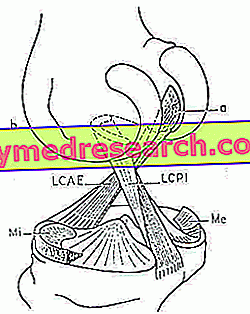By Dott.Luca Franzon
The Anterior Cruciate Ligament (ACL) is one of the cornerstones of knee stability. It avoids the anterior translational movement of the tibia on the femur. This structure is strongly stressed during various types of sports and its break is a fairly frequent event (see Tab 1). The lack of it alters the biomechanics of the knee with consequent sudden failures in the support on the affected limb, therefore further articular damages (meniscal and cartilaginous) that lead to an early joint arthrosis.
Often in the weight room we are faced with people who must rehabilitate or prepare for an ACL reconstruction intervention. The purpose of a rehabilitation program is to recover stability, mobility, strength, flexibility and the ability to re-execute certain technical gestures, trying to bring the traumatized limb to very similar values, if not identical to the period preceding the injury.
Surgery has made great strides regarding the techniques of reconstruction of the various joints, but the same cannot be said with regard to rehabilitation. After the injury, it is necessary to plan a rehabilitation program that includes a period of preparation for the intervention and a post-treatment rehabilitation period.
The pre-operative period is of fundamental importance because it will allow the traumatized person to present himself on the date of the operation with a good muscular tropism, therefore able to rehabilitate himself faster and better. The problem of the pre-operative period is that there are no precise studies on what is good to do, and too often we rely on chance, creating more damage than those present at the beginning. A

Once the day of the operation is over, the actual rehabilitation period will begin. There are different schools of thought. Shelbourne and Nitz propose an accelerated protocol with immediate total load and return to sport around the 4th month. Ehlenz, Grosser, Zimmermann propose an intensity of 40/60% number of repetitions 8-12 (ideal 10) slow rhythm and without interruptions, 3-5 series for princpanti 5-8 series for advanced athletes.
The big problem to be faced is that the current knowledge on the recovery and consolidation times of the implanted neo-ligament cannot establish when and with what loads rehabilitation exercises are really safe and effective. "The relationship between therapeutic exercises and the biomechanical behavior of the neo-ligament is not clear" (Beynnon 1992). Beynnon himself inserted an arthroscopic in vivo voltage transducer to record the deformation that the ACL undergoes during exercises closed and open kinetic chain. It is meant by open kinetic chain exercise "when the distal segment is free to move in space" (Palmitier 1991) while the exercise has a closed kinetic chain "when the disatale segment is fixed" (Palmitier 1991).
During rehabilitation it is essential to choose the right and least dangerous exercises in order to bring the athlete back to the optimal shape conditions. During exercises with an open kinetic chain it was found that in the last degrees of knee extension from 30 ° to 0 ° the stresses on the LCA are considerable. To prefer to the latter the exercises with closed kinetic chain that do not overload the operated ligament and determine a good stimulus for muscle development, all with a good security of not being harmful. The closed kinetic chain exercises also give the possibility to perform a co-contraction by the ischiocruralis which oppose the anterior sliding of the tibia on the femur. When performing closed kinetic chain exercises, the angle of flexion of the trunk will also be important, since "the more the hip flexes the more the muscles going from the ischium to the leg undergo a relative shortening and the more they tend" (Kapandji 1974 ).
During the extension movement to the leg extension considerable compression and shearing forces occur at the level of the ACL, so it is an exercise to be advised against for those who want to rehabilitate a knee especially in the first months post-surgery.
Everything seems clear at this point, ie those who have undergone ACL reconstruction should avoid open kinetic chain exercises and use those with closed kinetic chain. The theses described above have been questioned in an article published in "The American Journal of Sports Medicine" entitled "The Strain Behavior of the Anterior Cruciate Ligament During Squatting and Active Flexion-Etension. Exercise ". Beynonn, Johnson et al. their previous study (1995) has been updated and questioned, highlighting that "The maximum LCA tension values obtained during free squat did not differ from those obtained during an active flexion and extension performed in an open kinetic chain.

It is essential to work together with the doctors who performed the operation and ensure that the person we are acting on is subjected to the appropriate tests to see if the path taken is right or if it is appropriate to correct something in the running. Below I present a draft of what could be a set list to follow if you need to rehabilitate an ACL.
It is essential to work together with the doctors who performed the operation and ensure that the person we are acting on is subjected to the appropriate tests to see if the path taken is right or if it is appropriate to correct something in the running. Below I present a draft of what could be a set list to follow if you need to rehabilitate an ACL.
FROM 1st TO 5th DAY AFTER-OPERATION |
Slight lymphatic drainage massage |
Passive mobilization 0 ° -70 ° |
Patella mobilization |
Partial load with use of crutches |
Low frequency electrostimulator start |
FROM 6TH TO 15TH DAY |
Passive mobilization 0 ° -80 ° |
Walking with crutches |
Isometric contractions |
Low frequency electrostimulation |
Cognitive exercises in unloading through calcaneal support with use of maps |
Partial deflection on the wall 0 ° -70 ° / 0 ° -90 ° |
Search for the full extension |
cryotherapy |
FROM 16th TO 45th DAY |
Passive mobilization 0 ° -110 ° |
Passive bending at the wall 0 ° -100 ° |
Discharge cognitive exercises with use of maps |
Proprioceptivity from sitting with large and small balls |
Isometric contractions |
Mini bipodalic squats |
Bike from 5 to 10 minutes |
Bipodalic leg press |
Walking without crutches |
Full passive extension |
cryotherapy |
FROM 46th TO 60th DAY |
Walking with eyes closed |
Walk on uphill tapie roulant |
Cross and side step |
Proprioceptive tablet |
Elastic net |
Single-core squats 0 ° -30 ° (3x10) |
Isometric contractions |
Erect monopodalic postures with closed eyes |
Step 2-4 minutes with supporting arms |
Bike 15 minutes |
Monopodalic leg press in pyramidal shape |
Leg curl |
Stretching (PNF) |
Cryotherapy |
FROM 61 ° TO 120TH DAY |
Leg extensions 90 ° -30 ° |
Bike 20 minutes |
Step 5 minutes |
Leg curl |
Monopodalic leg press |
Tapie roulante 10 corsa |
Race on the spot, in a circle, kicked |
Jump rope |
Submaximal jumps |
Change of direction |
Bipedal and monopodalic stops on site |
FROM 120 ° TO 180 ° DAY |
Increase in loads on all isotonic machines |
Complete leg extension |
Cardio vascular training |
Race to 8 |
Side slips |
Maximum travel |
Maximum jump |
Dexterity exercises with specific tool |
Athletic paths |
BIBLIOGRAPHY
Shelboume KD, Nitz P: Accelerated rehabilitation after anterior cruciate ligament reconstruction. Am J Sports Med 18: 292-299, 1990
Beynnon BD, Pope MH, Wertheimer CM, et al: The effect of a functional knee brace on strain on the anterior cruciate ligament in vivo. J Bone Joint Surg 74A: 1298-1312, 1992
Beynnon BD, Johnson RJ, Fleming BC: The mechanics of anterior cruciate ligament reconstruction, in Jackson DW (ed): The Anterior Cruciate Ligament: Current and Future Concepts. New York, Raven Press, Ltd., 1993, pp. 259-272
Palmitier RA, An KN, Scott SG, et al: Kinetic chain exercise in knee rehabilitation. Sports Med 11: 402-413, 1991
Re-education after injury of the anterior cruciate ligament



